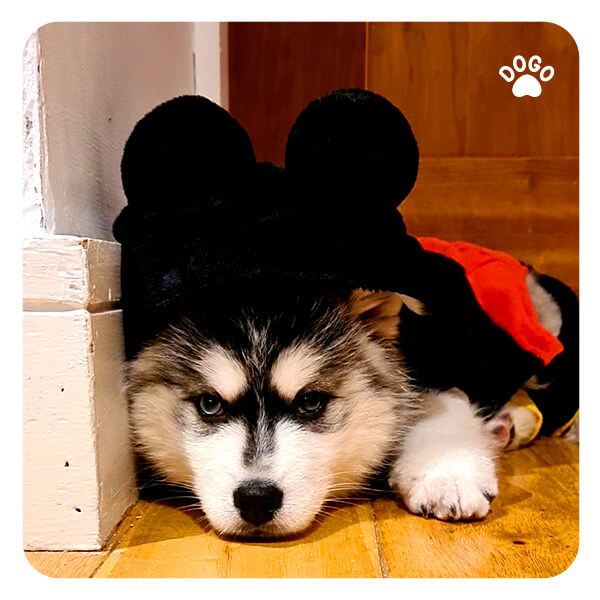Dog Alone in the House – How Long Can Your Dog Be Left Alone?
Post Date:
November 8, 2023
(Date Last Modified: November 13, 2025)
Many dog owners need to balance work and life demands with their pet’s welfare when deciding how long a dog can safely be left alone in the home.
Recommended Alone-Time Limits by Age and Life Stage
| Life Stage | Typical Maximum Alone Time | Bladder/Bowel Control Note | Crate Useful? |
|---|---|---|---|
| 8–10 weeks | 30–60 minutes[1] | Very limited hold capacity; needs frequent trips out[2] | Yes for short supervised naps[5] |
| 3–6 months | 2–4 hours[1] | Bladder control improving but still frequent breaks needed[2] | Yes if properly introduced[5] |
| 6–12 months | 4 hours typical; up to 6 hours for some adolescents trained gradually[1] | Size and age both determine interval between eliminations[2] | Depends on tolerance and comfort[5] |
| Adult (healthy) | 4–8 hours typical maximum for many adults under stable conditions[3] | Adult medium/large dogs often can wait longer than small breeds[2] | Useful when part of a routine but not always required[5] |
| Senior or medically compromised | Often less than adult maxima and individualized per case; may require checks every 2–4 hours[3] | Medical issues and medications commonly shorten safe alone time[2] | Can be helpful to limit movement and allow monitoring[5] |
Individual Factors That Affect How Long a Dog Can Be Left Alone
Breed and inherent energy level change the practical maximum alone time because working or high-energy breeds routinely need more activity and mental work than companion breeds; many working-breed programs recommend at least 60 minutes of vigorous activity daily for temperament balance[4].
Temperament and a dog’s history with separation can dramatically reduce tolerated alone time; dogs with separation-related behavior may show distress when left for even brief periods, and prevalence estimates and professional guidance stress individualized plans for these dogs[5].
Health conditions, recent surgeries, or medications that increase thirst, urinary frequency, or disorientation change the schedule; clinical references note that certain drugs and post-op protocols require monitoring and more frequent checks than general guidelines allow[2].
Housebreaking and bladder control vary widely with age and size, and a dog’s demonstrated daytime continence is one of the best practical predictors of how long it can wait comfortably and without health issues[2].
Potty, Exercise, and Basic Physiological Needs
Smaller and very young dogs typically need more frequent elimination breaks, and clinical manuals describe voiding intervals that are often linked to age in months and body size rather than a single rule; for example, kittens and puppies commonly cannot hold urine for the same span as adults and need scheduled outings much more often[2].
A recommended pre-departure routine for many dogs includes a 10–30 minute vigorous play or walk to reduce pent-up energy immediately before being left[4].
If medication timing is required, many veterinary sources recommend scheduling doses to coincide with the owner’s return or arranging a caregiver for mid-day doses; clinical dosing windows and when to give the next dose should be confirmed with the prescribing veterinarian[2].
Feeding schedules can affect elimination timing; for adult dogs, a consistent twice-daily feeding routine often produces predictable bowel patterns, whereas free-feeding can make timing less reliable for planning alone time[3].
Mental Stimulation and Environmental Enrichment While Alone
Puzzle toys, food-dispensing devices, and long-lasting chews can reduce boredom-related behaviors by providing mental work and a slow-reward structure during absences[4].
Background audio or TV tuned to calm programming and scent-based enrichment such as scent trails or hidden food can reduce acute stress markers in some dogs, according to practitioner recommendations for home enrichment[4].
Rotate toys on a weekly schedule to keep novelty and engagement high rather than leaving the same items accessible continuously, which tends to reduce interest over time[4].
Training and Desensitization to Increase Alone Tolerance
Systematic desensitization using short departures that gradually increase in duration is a standard behavior technique; many trainers recommend starting with departures under one minute and building up slowly while reinforcing calm behavior[5].
Crate training can help some dogs feel secure and provide a den-like environment, but it should be introduced carefully and never used as punishment; for puppies and some anxious dogs, short, positive crate sessions before lengthening alone time are advised[5].
Creating low-key departure cues and neutral returns—avoiding dramatic goodbyes and exuberant reunions—reduces the arousal cycle that can reinforce separation stress and helps the dog learn that departures are ordinary[5].
Recognizing Signs of Distress and Separation Anxiety
Common behavioral signs to watch for include excessive vocalization, destructive behavior focused on doors or furniture, and inappropriate elimination while alone[5].
Physical or stress signals such as pacing, excessive drooling, inappetence, or self-trauma (e.g., chewing or licking paws until raw) can indicate heightened anxiety and warrant professional evaluation[2].
When signs are frequent, intense, or cause injury or neighbor complaints, consult a veterinarian or a certified applied animal behaviorist to develop a behavior modification plan plus possible medical support[3].
Home Safety and Proofing for Unattended Dogs
Secure toxins, human medications, cleaning products, and small items that invite ingestion because unsupervised dogs may explore and consume hazardous items during stress or boredom; professional guidance emphasizes inaccessible storage for all hazardous materials[3].
Maintain safe ambient temperatures; extreme heat or cold in the home can make even a normally tolerant dog at risk during extended absences and should be accounted for with thermostatic control and monitoring when owners are away[3].
Provide continuous access to fresh water in a stable bowl or dispenser and remove access to cords or dangling items that might cause entanglement or chewing injuries[3].
Alternatives to Extended Alone Time
- Hiring a dog walker or midday pet sitter for bathroom breaks and exercise
- Using dog daycare for full-day social and supervised options
- Arranging neighbor, family, or pet-share help for routine coverage
- In-home pet sitting when overnight or long absences are necessary
Technology to Monitor and Comfort Your Dog Remotely
Video cameras with two-way audio and motion alerts allow owners to check on a dog visually and to speak to them; many systems send activity alerts when unusual patterns are detected, which owners and professionals use to triage behavior[4].
Automated feeders and treat dispensers can maintain feeding schedules or reward calm behavior during absences, and activity monitors can log general activity levels and sleep patterns to identify trends over days or weeks[4].
When Not to Leave a Dog Alone and Emergency Planning
Do not leave a dog alone following surgery or when the dog has acute illness without direct instruction from the treating veterinarian; many post-operative protocols require observation or medication administration for at least the first 24–72 hours[2].
A written emergency plan that lists an emergency contact, the regular veterinarian, and a nearby 24-hour clinic is recommended; having a neighbor or sitter with a spare key and clear instructions reduces response time if a problem arises[3].
Consider pet insurance and a designated local caregiver when planning extended travel or when a dog’s medical or behavioral profile increases the risk of problems during absences[3].




